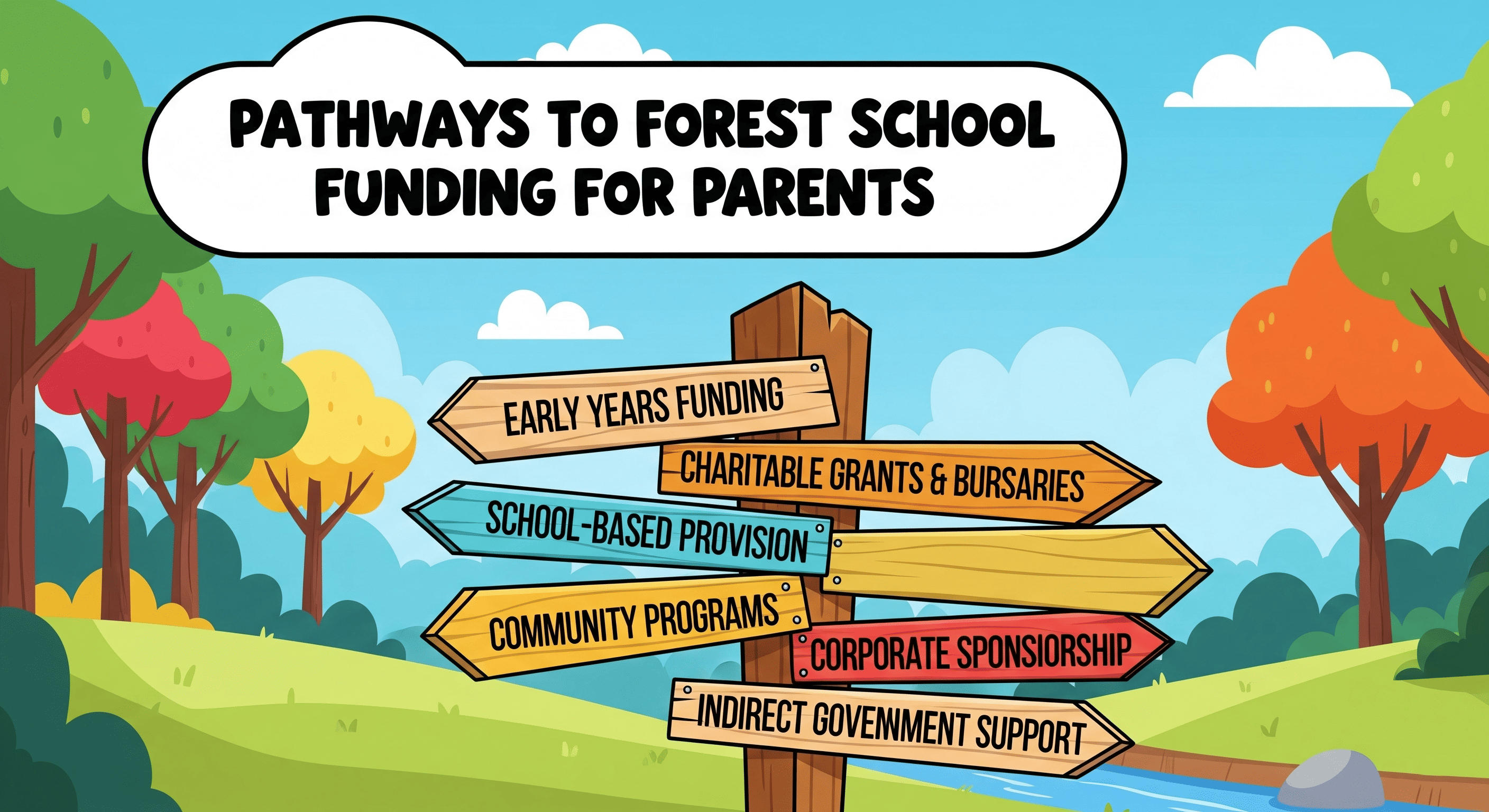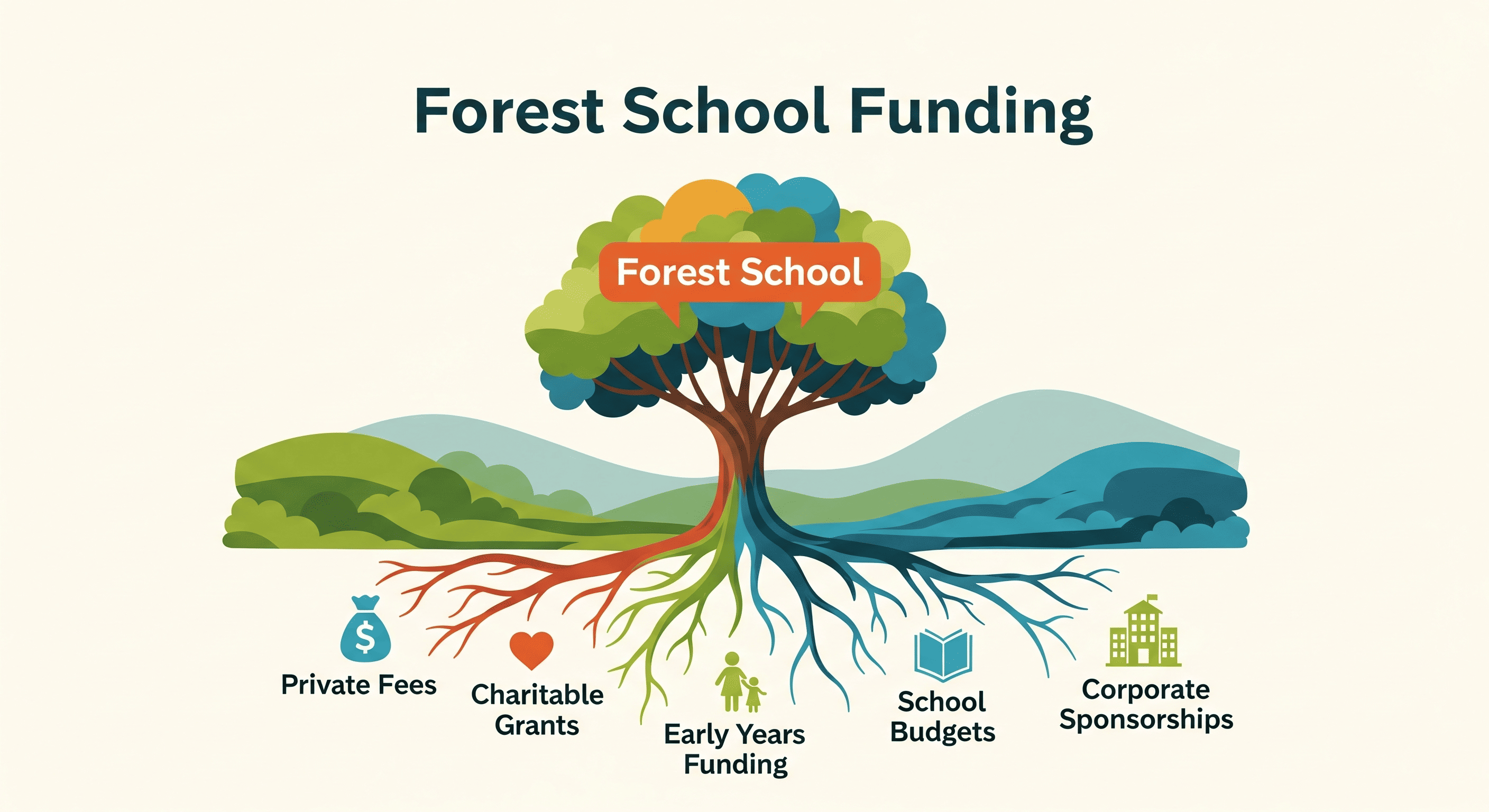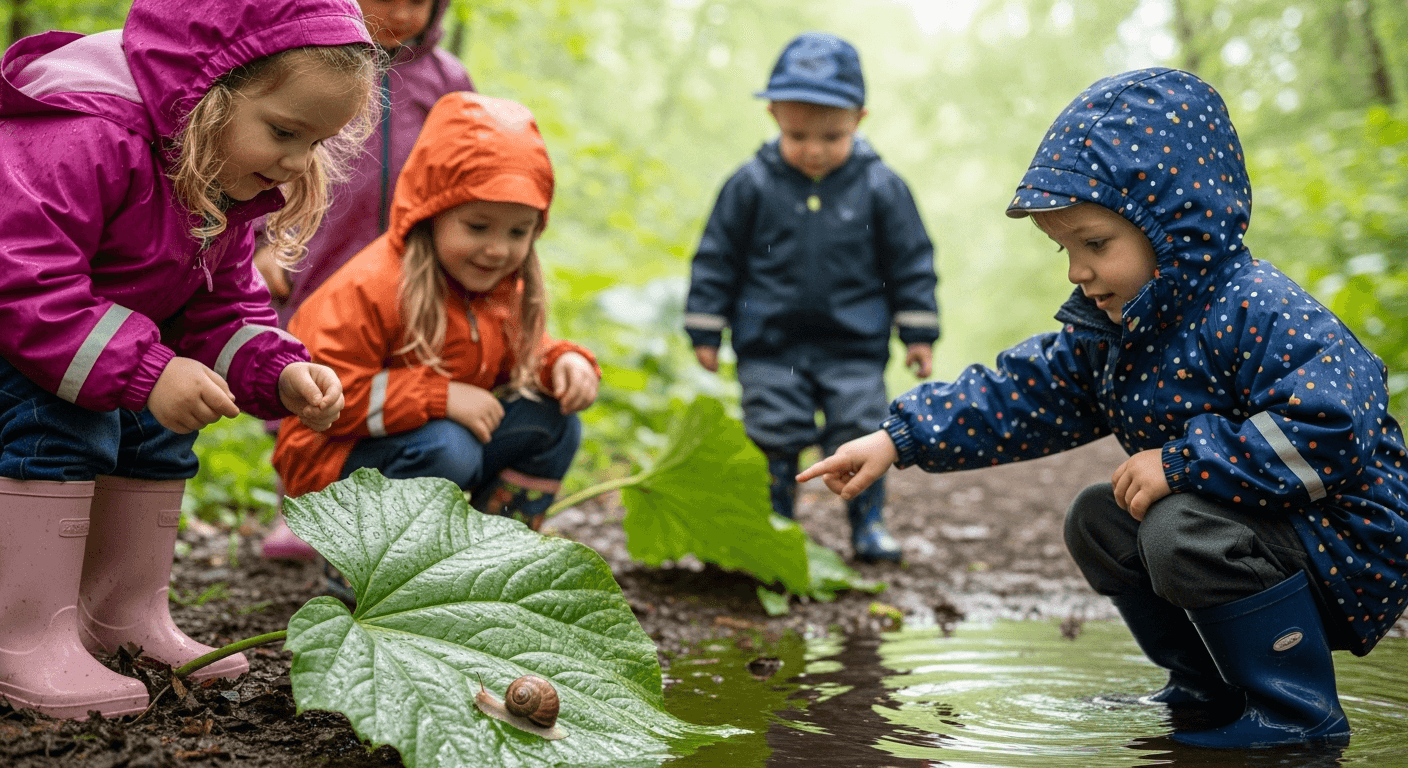· Education · 11 min read
Forest School Costs in the UK: Fees, Funding, and Free Options Explained
Dive deep into the practical costs of Forest School in the UK. From understanding what drives pricing to discovering free and low-cost options, this comprehensive guide helps parents navigate the financial landscape of outdoor education.

Welcome back to our comprehensive exploration of Forest School funding in the UK. In part 1, we established that Forest Schools don’t receive direct national government funding, relying instead on a diverse patchwork of private fees, charitable grants, and various support mechanisms.
Now, in this second and final part of our series, we’ll dive into the practical aspects that matter most to parents: understanding the actual costs, what drives these fees, and most importantly, how to access affordable or even free Forest School opportunities for your child.
Understanding What Drives Forest School Costs
Understanding what drives Forest School pricing helps parents appreciate the value behind the fees and make informed decisions about different providers. The cost of Forest School varies significantly across the UK, reflecting the unique pedagogical approach and operational requirements that distinguish Forest Schools from traditional educational settings. These variations stem from several key factors that reflect the unique nature of outdoor learning:
- High Staffing Ratios & Qualified Practitioners: Forest Schools require higher adult-to-child ratios (often 1:6 or 1:4) for safety and child-led learning, significantly increasing staffing costs (accounting for 60-70% of total operational costs). These roles demand highly trained, Level 3 qualified practitioners, adding a premium to wages.
- Specialised Equipment & Site Maintenance: Essential gear like safety equipment, child-appropriate tools, and fire equipment, along with ongoing maintenance of the woodland site, represent substantial investments. Unlike indoor resources, outdoor equipment faces constant wear, and site management includes regular safety checks and environmental care, plus potential transport costs for off-site locations (£20-£30 per child per session).
- Session Length & Program Depth: The Forest School philosophy emphasizes long-term engagement (e.g., minimum 24 weeks over two terms). This commitment leads to higher costs for year-round site maintenance, competitive staff compensation to ensure low turnover, and continuous curriculum development across seasons.
- Location: Costs are significantly influenced by geography. London and the South East typically have 30-50% higher rates due to increased property and wage costs. Rural areas may have lower operational costs but potentially higher transport expenses for families, while urban providers face higher site rental costs.
- Insurance & Regulatory Compliance: Due to the outdoor nature and activities involving tools and fire, Forest Schools face unique and often higher insurance requirements (public liability, professional indemnity, equipment, activity-specific coverage). Compliance with regulatory bodies like Ofsted also adds to administrative and training overheads.
Typical Cost Ranges for Forest Schools in the UK
Understanding the cost landscape helps parents budget effectively and identify value-for-money options. Forest School costs vary dramatically based on provider type, duration, and target age group. To give you a clearer picture, here’s an approximate breakdown of what you might expect to pay, though prices will always vary by provider and region.
| Type of Provision | Session Duration | Typical Cost | What’s Often Included | Potential Additional Costs |
|---|---|---|---|---|
| Independent Forest School Nurseries (2-5 years) | Full Day (8 hrs) | £80-£150 per day | Basic care, qualified staff, equipment use | Meals, transport, enhanced activities |
| Half Day (4 hrs) | £45-£80 per session | Basic care, qualified staff, equipment use | Meals, transport | |
| Weekly (3 full days) | £240-£450 per week | Basic care, qualified staff, equipment use | Meals, transport, holiday care | |
| Specialist Private Providers (5-16 years) | 2-hour session | £25-£45 per child | Qualified instruction, equipment, basic activities | Transport, meals, extended activities |
| Full day program | £80-£150 per child | Qualified instruction, comprehensive program | Transport, meals | |
| Individual/SEN, 1:1 (all ages) | £80-£120 per session | Specialist practitioner, tailored program | Transport, equipment hire | |
| Independent Schools (4-18 years) | Integrated program | £6,000-£12,000 per term | Full curriculum integration, all activities | Residential trips, specialist equipment |
| State Schools (4-11 years) | Weekly sessions | Usually free | Basic program within school budget | Optional enhanced activities, trips |
| Community Programs (3-16 years) | Weekly sessions | £5-£25 per session | Basic activities, volunteer support | Equipment hire, transport |
| Holiday Programs (5-16 years) | Daily (1 week) | £150-£350 per week | Daily activities, qualified staff | Meals, transport, equipment |
Regional Variations: Costs vary significantly across the UK:
London and South East: Premium rates of 30-50% above national average. Full day nursery: £120-£200; Half day sessions: £60-£100; Independent school integration: £8,000-£15,000 per term.
Northern England and Scotland: Generally 20-30% below national average. Full day nursery: £60-£120; Half day sessions: £35-£65; Independent school integration: £4,000-£8,000 per term.
Wales and Southwest: Moderate pricing with good value options. Full day nursery: £70-£130; Half day sessions: £40-£70; Independent school integration: £5,000-£9,000 per term.
Hidden Costs to Consider: Parents should budget for additional expenses that may not be immediately apparent:
Appropriate clothing: Waterproof, durable outdoor gear (£50-£150 per child).
Transport: Travel to off-site locations (£5-£20 per session).
Registration Fees/Deposits: Common for nurseries or long-term bookings.
Is Forest School Free? Exploring Accessible & Low-Cost Options
While a truly “free” Forest School experience for all is not universal, there are numerous pathways to significantly reduce costs or access completely free provision. Understanding these options is crucial for parents seeking affordable outdoor education opportunities.
1. Early Years Funding: The Foundation of Accessibility
For families with young children, Government-funded “free early education” hours represent the most significant pathway to affordable Forest School access.
- Government Entitlements:
- 15 hours free: All 3-4 year olds, and some 2-year-olds from disadvantaged backgrounds.
- 30 hours free: Available for eligible working families meeting specific criteria.
- Coverage: 38 weeks per year, term-time only.
- How It Works with Forest Schools: Many Forest School nurseries are registered Early Years providers, accepting funded hours. However, parents should understand:
- Enhanced provision charges: Additional fees for specialist Forest School elements (£10-£25 per week).
- Consumables: Charges for meals, snacks, and materials (£5-£15 per day).
- Extended hours: Costs for sessions beyond funded hours (standard rates apply).
- Maximizing Early Years Funding:
- Choose providers offering full integration of Forest School within funded hours.
- Understand what’s included in the “free” provision versus additional charges.
- Consider split placements between funded and fee-paying providers for extended Forest School exposure.
2. Charitable Grants and Bursaries
A robust ecosystem of charitable support exists for Forest School access, particularly targeting disadvantaged children and families.
- National Charitable Foundations:
- The Wildlife Trusts: Recipient of £300,000 from People’s Postcode Lottery for Forest School programs in urban areas, specifically targeting inner-city children with limited nature access.
- National Lottery Community Fund: Awards for All grants (£300-£10,000) support local Forest School initiatives, particularly those serving communities with limited outdoor education access.
- CLA Charitable Trusts: Grants up to £5,000 specifically for countryside access projects, explicitly mentioning Forest School-type activities for disadvantaged young people.
- Ernest Cook Trust: Outdoor Essentials Grant provides £1,000 to state-funded secondary and special schools for outdoor learning, including transport costs to Forest School venues.
- Application Strategies:
- Focus on clear benefits for disadvantaged children.
- Demonstrate community need and limited alternative provision.
- Provide detailed budgets showing cost-effectiveness.
- Include letters of support from schools, health professionals, or community leaders.
3. School-Based Free Provision
Many parents overlook the Forest School opportunities available through their child’s existing school.
- State Schools: Some employ qualified Forest School practitioners, with costs absorbed within general school budgets. These are often integrated into the curriculum rather than additional charges and may offer after-school or holiday programs at minimal cost.
- Private Schools: Comprehensive programs are often included in school fees, leveraging extensive grounds and facilities. They may also offer community access programs and scholarship/bursary programs that include Forest School access.
- Academy Trusts: Some multi-academy trusts invest in Forest School provision across their schools, sharing resources and practitioners to reduce individual school costs, and may offer programs to local community schools.
4. Community and Voluntary Sector Programs
Local organizations often provide the most accessible Forest School opportunities:
- Youth Groups: Scouts, Guides, and other youth organisations may incorporate Forest School principles into their activities at minimal cost.
- Environmental & Conservation Groups: Local wildlife trusts, environmental centres, and conservation groups frequently offer subsidised or free Forest School programs.
- Local Community Funds: Check for grants from local supermarkets (e.g., Tesco Bags of Help, Asda Foundation) or other community initiatives that might support outdoor learning projects in your area.
- Accessing Community Programs: Contact local volunteer bureaus for information about youth programs, check with environmental centers and country parks, inquire at libraries and community centers, and connect with parent networks and school communities for recommendations.
5. Corporate and Business Sponsorship
Businesses increasingly recognize the value of supporting Forest School initiatives:
- Local Business Sponsorship: Companies often sponsor local Forest School programs as part of corporate social responsibility, potentially providing funding for specific children, families, equipment, or venue donations.
- National Corporate Programs: Supermarket community funds (Tesco Bags of Help, Asda Foundation), utility company community investment programs, and corporate foundation grants for education and environment initiatives.
- Approaching Sponsors: Prepare clear proposals showing community benefits, offer recognition opportunities, demonstrate measurable outcomes, and consider ongoing partnerships.
6. Indirect Government Support
While not direct Forest School funding, other government support for outdoor learning indirectly benefits the sector. The Department for Education (DfE) allocates grants through programs like the National Education Nature Park, supporting educational settings in purchasing equipment and transforming “grey” spaces into greener, more biodiverse areas. This indirectly enhances outdoor learning environments where Forest School activities might take place.
Navigating Funding and Finding Support for Your Child
Successfully accessing affordable Forest School opportunities requires a strategic approach, combining multiple funding sources and support mechanisms.
Step-by-Step Funding Strategy
- Assess Your Eligibility: Check Early Years Funding entitlements through your local authority, verify childcare voucher scheme eligibility through your employer, research Tax-Free Childcare scheme benefits (up to £2,000 annually), and identify any special educational needs or disadvantaged circumstances that may qualify for additional support.
- Research Local Providers: Use our Forest School Finder to identify options. Contact them directly to inquire about their fee structure, acceptance of funded hours, and any available bursaries or discounts.
- Explore Grant Opportunities: If eligible, research national and local charitable grants that support outdoor learning or provide assistance for families.
- Maximize Multiple Sources: Consider combining Early Years Funding with other benefits (like Tax-Free Childcare) or seeking partial bursaries to cover “enhanced provision” charges.
- Connect with Networks: Speak to other parents, school communities, or local authority childcare teams for recommendations and information on local support.
Building a Support Network
- Parent Networks: Connect with other parents seeking Forest School opportunities to share costs, transport, and information.
- School Communities: Work with parent associations and school leadership to advocate for Forest School provision or group bookings.
- Local Authority Support: While not direct funders, local authorities often have information about grants, approved providers, and community programs.
- Professional Networks: Teachers, health visitors, and social workers often have knowledge of funding opportunities for specific circumstances.
Long-term Financial Planning
- Budget for Progression: Plan for your child’s continued participation as they grow, understanding that costs may increase with age and program complexity.
- Investment Perspective: Consider Forest School costs as a long-term investment in your child’s development, potentially reducing future needs for therapeutic or remedial support.
- Flexible Arrangements: Look for providers offering flexible payment terms, seasonal programs, or part-time options.
The Enduring Value: Why Forest School is Worth the Investment
While navigating the costs and funding options for Forest School can seem daunting, it’s essential to remember the profound and lasting benefits that justify this investment in your child’s development.
Forest School participation consistently yields significant returns across multiple developmental domains:
Holistic Development: It fosters emotional well-being (confidence, resilience, reduced stress), improves social skills (communication, empathy, collaboration), enhances physical development (motor skills, spatial awareness), and stimulates cognitive growth (curiosity, problem-solving, creativity).
Life Skills & Nature Connection: Children develop crucial life skills like risk assessment, independence, and mental health resilience. Crucially, it helps them form a lasting appreciation for the environment, addressing the modern “nature deficit.”
Long-Term Benefits: From an economic perspective, this investment can reduce future needs for therapeutic support, enhance educational outcomes, contribute to better physical and mental health, and build social capital. It provides a healthy balance to screen time and encourages physical activity in an increasingly sedentary world.
Conclusion: Making Forest School Accessible for Every Child
The journey through Forest School costs and funding options reveals a complex but navigable landscape. While the initial investment may seem substantial, the combination of funding sources, support mechanisms, and long-term benefits makes Forest School accessible to families across different economic circumstances.
Key takeaways for parents:
- Multiple pathways exist: From Early Years Funding to charitable grants, numerous routes can reduce or eliminate Forest School costs.
- Proactive research pays off: Taking time to explore funding options and provider varieties can unlock significant savings.
- Community resources matter: Local organizations, businesses, and networks often provide the most accessible opportunities.
- Long-term value justifies investment: The developmental benefits of Forest School participation extend far beyond the immediate costs.
The growing recognition of Forest School’s value, combined with increasing funding support from charitable organizations and government initiatives, suggests that accessibility will continue to improve. For parents committed to providing their children with transformative outdoor learning experiences, the investment in time to research funding options and in resources to support participation yields immeasurable returns in their child’s development and future success.
Remember, the goal isn’t just to find a Forest School opportunity, but to find the right one for your child that fits your family’s circumstances and values. Use our Forest School Finder directory to explore local providers, compare options, and begin conversations about funding and accessibility. The perfect outdoor learning adventure for your child is waiting to be discovered.



